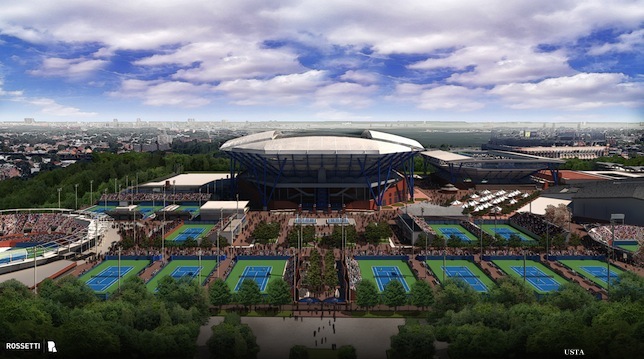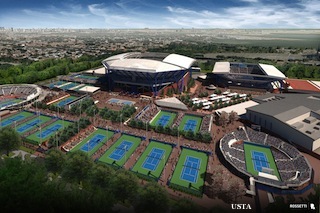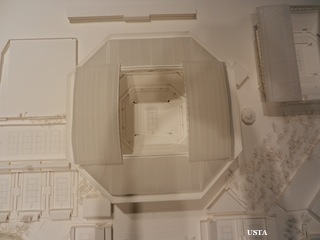
USTA Executive Director and Chief Operating Officer Gordon Smith eyed the crowd. A sea of reporters in front of him and media from around the world stared back at him on the web. He shifted his attention to the reporter holding the microphone.
"How much thought has been given to covering the third show court, considering the arms race you're in with other majors?" the reporter asked.
Smith smiled. "You really had to ask that question?"
Although the United States is not on Cold War-like terms with Australia, Britain and France, there is no denying the three other foreign grand slam hosts have upped their ante. Quite literally, the ante refers to changes the Australia Open, Wimbledon and Roland Garros have accomplished when spectators look up.
In Melbourne, Rod Laver Arena opened with a retractable roof in 1988. Neighboring Hisense Arena opened with a retractable roof in 2008 and Margaret Court Arena will boast a roof by 2015. In London, Wimbledon's Centre Court added a retractable roof in 2009 and the French Open announced a proposal for a roof over Court Philippe Chatrier in 2009 (further details announced in 2013, renovations expected to be finished by 2018).
On Thursday in a press conference in New York City, the USTA announced plans to close the gap (or roof) between the U.S. Open and its competitors with $550 million in renovations.
Arthur Ashe Stadium, the largest outdoor tennis venue in the world (22,547 capacity) will have a retractable roof added to its résumé. According to Danny Zausner, the COO of the National Tennis Center, the roof could be ready for the 2016 U.S. Open, although 2017 is the more likely expectation.
Along with the Arthur Ashe Stadium roof, renovations at the Billie Jean King Tennis Center will involve Louis Armstrong Stadium and the Grandstand. Louis Armstrong Stadium will expand from 10,000 seats to 15,000 seats, which would put it in a tie for the fifth-largest outdoor tennis stadium in the world. The former center court will also be equipped with a retractable roof of its own.

The Grandstand shifts from its current location adjacent to Louis Armstong Stadium to a new location across the campus. Capacity will expand from 6,000 to 8,000 seats and the new venue will be built deeper into the ground.
As part of the renovation, extra seating will also be added to practice courts and side courts will be moved south to widen walking space.
Currently, the U.S. Open brings in more than 700,000 fans a year during its two-week annual life. According to The New York Times, of the USTA's $302 million income in 2012, $223 million comes from the Flushing Meadows fortnight.
The USTA expects the new renovations to cause a spike in both attendance and money. An estimated 10,000 more tickets will be sold for day sessions, as about 40,000 is the current day session maximum. With the Grandstand moving away from the main entrance and more food options built near the new stadium, the courts will spread out.
Smith addressed any concern as to whether or not ticket holders will be forced to pay higher prices to satisfy the needs of the project.
"I think we've made it clear on every occasion, we're not going to pay for this on the backs of our ticketholders," he said. "That's not one of the funding mechanisms that we're looking at."
USTA President Dave Haggerty would not go into specifics, but he explained a bit of the payment process.
"The USTA has had a number of projects over the years," he said. "We've done self-funding. There will be a combination of bond funding and also through some revenue generation that we will achieve it."
With more patrons coming into the tennis center and more reserved seats being sold in Louis Armstrong Stadium and the Grandstand, the USTA expects to increase its revenue from the event. Zausner says although retail and food options are a "fan enhancement," the merchandise and food additions will not be seen as a source of revenue "driving the construction."
The revenue made will not go without a nod to Corona Park.
"Part of this process has been for us to reconnect in a better way to the park and to the neighborhoods," Smith said. "We have committed up-front funding for some capital projects and on going funding to be part of a conservancy to part of a better future for Flushing Meadows park."
The architectural firm leading the project is ROSSETTI. In 2009, the USTA actually turned down the firm's ideas in favor of another design. Matt Rossetti, son of founder Gino Rossetti, continued working on designs anyway with his team. The USTA reconnected with ROSSETTI in 2010 and expects to work with them until the project finishes in 2018.
"We had to find out how to support 5,000 tons of steel on soil that is mush," Matt Rosetti said of the earth under Arthur Ashe Stadium.
The blueprint calls for a 250-feet-by-250-feet opening with 20 piles driven into the ground from 150 to 200 feet deep for support. When the roof is fully closed, its surface area covers about 200,000 square feet.
Unlike the fold-up roof used at Wimbledon's center court that has an expected 10-year shelf life, the Arthur Ashe Stadium will live a couple decades longer.
"The material is a PTFE fabric, which is a fancy way of saying it's a Teflon coating, which is genius," Rosetti said. "It allows the roof fabric to have a minimum of 30-year lifespan. It keeps it cooler underneath. At the same time, it allows a diffuse amount of light to come in, providing a lot of light in the stadium without having shadowing on the court."
Behind the scenes, a gutter system 24 feet wide and six feet deep will be around the perimeter of the structure to guzzle rainwater. A catwalk system for lighting, sound and other necessities will be built. Hunt Construction Group, which built the Barclays Center in Brooklyn and Citi Field in Queens, will construct the roof.
Zausner said he began looking into roof options as far back as 2002. Although statistical data for the prior century showed the weeks before and after Labor Day as one of the driest periods of the year in New York, the USTA recognizes rainouts have been more frequent in the last decade. It is hard to deny this considering the U.S. Open finished on a Monday (one day late) for the fifth straight year in 2012.
ROSSETTI's design negates problems regarding the mushy soil of Queens.
"The overall structural weigh of the superstructure is considerably less than some of the other previous designs which allowed us to have a different level of bearing capacity," Rossetti said. "…Typically you connect pile caps with Grade beams. The grade beams complicate all of the infrastructure and utilities that are emanating out of Ashe. We were able to not do that and instead buttress these pile caps."
A giddy Smith followed: "Hopefully, starting as early as 2016, we will never have to postpone [the Open] again." A definite Sunday finish should improve revenue.
For over a decade the idea of bringing a roof to Arthur Ashe Stadium has been tossed around. Architects have tried their hand at all kinds of styles, as other nations took steps forward. On Thursday, the USTA announced it is ready to play its cards in the retractable tennis roof business.

Here's the sure information: The renovated grounds will feature a retractable roof on Arthur Ashe Stadium that is three to four times the size of Wimbledon's roof, a retractable roof on a larger Louis Armstrong Stadium, a larger and relocated Grandstand, food and retail locations spread away from the congestion of the main gate, a more open pedestrian and fan esplanade and a new area for practice court viewing.
Revenue and attendance generated from the $550 million project will not be defined for a decade or so, although the USTA expects both to improve.
Returning back to the opening question, Smith is unsure whether the Grandstand will eventually have a third roof. This is a question still to be pondered.
"I'll simply say it's not part of the plan between now and 2018 for this project," he said.
Above all, the USTA insists the renovations will satisfy the organization's main goal.
"It's great for the U.S. Open. It's great for the city of New York. But to us, it's great for tennis," Smith says. "Why is it great for tennis? Because having done all of these things, we still have to do the primary thing we exist for, and that's to promote and develop the growth of tennis in the United States."
One slight concern of the Arthur Ashe Stadium roof shape is that, purposefully or not, the structure resembles the logo of JP Morgan Chase, a traditional sponsor of the U.S. Open. When asked about it, Smith sharply responded, "We've noticed the similarity as well."
As for the environmental details of the project, being green is a topic of conversation. It is going to be considered during the construction process.
"Throughout the three years of the master planning and design work we've been working on, it's been an integrated part of all the design," Rossetti said. "There are some buildings that will be specifically lead certified, transportation building, Grandstand, parts of the south campus. Then there are other venues that may not be certified."
Despite all the money, time and work being poured into the renovations, the USTA still has one message about the state of the U.S. Open. It is and will always be an outdoor-based tournament.
In an ideal year, Haggerty has his estimate of the amount of matches that would be played under a roof.
"The answer is we would like to never have to play one with the roof closed."
Arthur Ashe Stadium will soon have a 200,000 square foot retractable roof. Just in case.
-- Follow Jeffrey Eisenband on Twitter @JeffEisenband.





